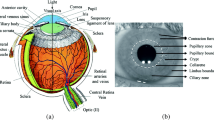Abstract
This paper presents a robust, reliable iris location system for close-up, grey scale images of a single eye. The system is meant as a bootstrap or recovery module for automated iris tracking within medical applications. We model the iris contour with an active ellipse, sensitive to intensity gradients across its perimeter. In this way, we avoid modelling the noisy appearance of the iris (e.g. corneal reflections). The iris–sclera intensity transition is modelled at two spatial scales with Petrou–Kittler optimal ramp filters. The optimal ellipse is identified by a simulated annealing algorithm tuned to the problem characteristics. The system performed accurately and robustly with 327 real images against substantial occlusion levels and varying image quality, subject, eye shape and skin colour.









Similar content being viewed by others
References
Blake A, Yuille AL (1992) Active vision. MIT, Cambridge
Duchowsky AT (2003) Eye tracking methodology. Springer, Berlin Heidelberg New York
Bettinger F, Cootes TF, Taylor CJ (2002) Modelling facial behaviours. In: Proceedings. BMVC’02, vol 2, pp 797–806
Luo B, Hancock ER (2001) Structural graph matching using the EM algorithm and simulated annealing. IEEE Trans PAMI 23(10)
Morimoto CH, Koons D, Amir A, Flickner M (2000) Pupil detection and tracking using multiple light sources. Image Vis Comput
Cristinacce D, Cootes TF (2003) Facial feature detection using ADABOOST with shape constraints. In: Proceedings of BMVC’03, 1:231–240
Daugman J (2004) How iris recognition works. IEEE Trans Cir syst video technol 14(1)
Davis RH, Twining C, Cootes T, Taylor C (2002) A minimum description length approach to statistical shape modelling. IEEE Trans Medical Imaging 21:535–527
Tan HL, Gelfand SB, Delp EJ (1992) A cost minimization approach to edge detection using simulated annealing. IEEE Trans PAMI 14:3–18
Isard M, Blake A (1998) Active contours. Springer,Berlin Heidelberg New York
Daugman J (1993) High confidence visual recognition of persons by a test of statistical independence. IEEE Trans PAMI 15(11)
Ivins JP, Porrill J, Frisby JP (1997) A deformable model of the human iris driven by non-linear least-squares minimisation. In: Proceedigns of IPA’97, 1:234–238
Weber J, Malik J (1994) Robust computation of optical flow in a multi-scale differential framework. Int J Comput Vis
Kerrigan S, McKenna S, Ricketts IW, Widgerowitz C (2003) Analysis of total hip replacements using active ellipses. In: Proceedings of Medical Images Understanding and Analysis (MIUA)
Leroy B, Medioni GG, Johnson E, Matthies L (2001) Crater detection for autonomous landing on asteroids. Image Vis Comput 19(11):787–792
Ingber L (1989) Very fast simulated re-annealing. Mathematical and computer modelling 12:967–973
Ma L, Tan T, Wang Y, Zhang D (2003) Personal identification based on iris texture analysis. IEEE Trans PAMI 25(12)
Petrou M, Kittler J (1991) Optimal edge detectors for ramp edges. IEEE Trans. PAMI 13
Vincze M, Ayromlou M, Zillich M (2000) Fast tracking of ellipses using edge-projected integration of cues. In: International Conference on Pattern Recognition (ICPR’00)
Ritter N, Owens R, Cooper J, Eikelboom R, van Saarlos PP (1999) Registration of stereo and temporal images of the retina. IEEE Trans Med Imaging 18(5)
Salamon P, Sibani P, Frost R (2002) Facts, Conjectures and Improvements for Simulated Annealing. SIAM
Shih S-W, Liu J (2004) A novel approach to 3-d gaze tracking using stereo cameras. IEEE SMC (Part B) 34(1):234–245
Ramadan S, Abd-Almageed W, Smith CE (2002) Eye tracking using active deformable models. In: Proceedings of ICVGIP’02
Richard S (2004) Comparative experimental assessment of four optimisation algorithms applied to iris location. Master’s Thesis, ECE/EPS, Heriot-Watt University
Cornsweet TN, Crane HD (1973) Accurate two-dimensional eye tracker using first and fourth Purkinije images. J Opt Soc Am 63(8):921–928
Author information
Authors and Affiliations
Corresponding author
Rights and permissions
About this article
Cite this article
Trucco, E., Razeto, M. Robust iris location in close-up images of the eye. Pattern Anal Applic 8, 247–255 (2005). https://doi.org/10.1007/s10044-005-0004-8
Received:
Accepted:
Published:
Issue Date:
DOI: https://doi.org/10.1007/s10044-005-0004-8




